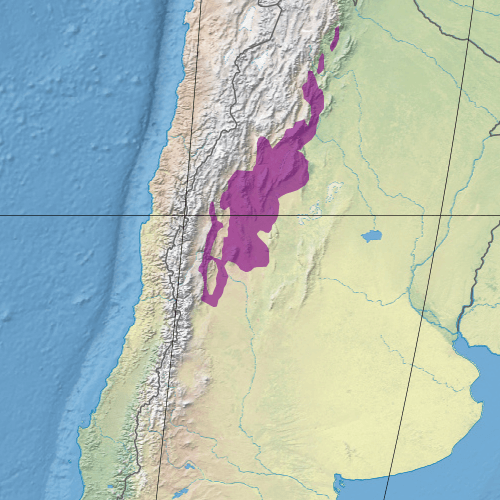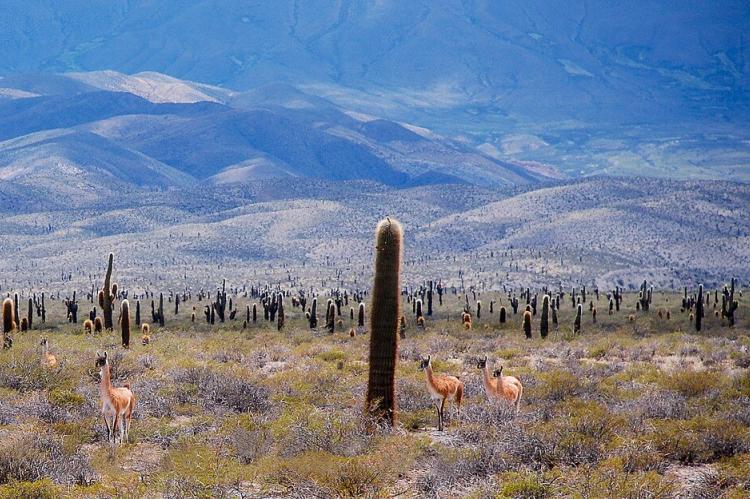Argentina's High Monte: Life in the Arid Highlands
The High Monte ecoregion, extending along the eastern Andean slopes of northwestern Argentina, encompasses montane arid landscapes. The region supports diverse vegetation communities. Despite harsh conditions, the High Monte harbors exceptional biodiversity.
The High Monte: Argentina's Arid Andean Slopes of Resilience and Diversity
Geography and Location
Nestled along the eastern slopes of the Andes in northwestern Argentina, the High Monte ecoregion stands out as a landscape of remarkable ecological significance despite its harsh, arid character. This expansive montane region extends approximately 870 kilometers (540 miles) from near Salta in the north to Mendoza in the south, lying between the towering Andean cordillera and the Sierras Pampeanas to the east. The ecoregion encompasses a complex topography of longitudinal valleys, closed basins known as bolsones, and mountainous terrain that rises dramatically from valley floors at approximately 800 meters (2,625 feet) to upper elevations of 3,000 meters (9,843 feet).
The High Monte forms part of South America's Arid Diagonal, a vast belt of arid and semi-arid regions stretching across southern South America. This diagonal zone, shaped by the Andes' rain shadow and influenced by cold oceanic currents, forms one of the continent's most extensive dry regions. The complex topography, with mountain ranges creating barriers and valleys serving as refugia, has promoted the evolution of numerous endemic species over millions of years.
Climate and Ecosystems
The High Monte experiences a temperate arid to semi-arid climate with mean annual rainfall ranging from less than 100 millimeters (3.9 inches) in the driest valleys to 450 millimeters (17.7 inches) in more favored locations. Crucially, most precipitation falls during the southern hemisphere summer months (December through March) when the South American monsoon system brings moisture to the region. This summer rainfall regime distinguishes the High Monte from the lower-elevation Argentine Monte, which experiences colder temperatures and more evenly distributed precipitation.
Temperature patterns reflect both latitude and elevation. Summer daytime temperatures commonly reach 25 to 30°C (77 to 86°F) in valley bottoms, while winter brings cold conditions with nighttime temperatures frequently dropping below freezing. The region experiences pronounced diurnal temperature fluctuations, with differences of 20°C (36°F) or more between day and night not uncommon. These extreme temperature swings, combined with intense solar radiation, low humidity, and strong winds, create challenging conditions demanding remarkable adaptations.
The High Monte landscape features a mosaic of vegetation communities dominated by evergreen xerophytic shrubs that withstand extended drought. Shrubs of the genus Larrea, locally known as jarillas, form the backbone of plant communities across much of the ecoregion. Three principal species occupy different ecological niches: Larrea cuneifolia dominates the hottest and driest locations, Larrea divaricata thrives along stream courses, while Larrea nitida occurs in cooler areas and on mountain slopes.
Where groundwater approaches the surface or along watercourses, xerophilous open woodlands develop, dominated by species of Prosopis (algarrobo or mesquite). Prosopis alba and Prosopis nigra grow 4 to 16 meters (13 to 52 feet) in height, accessing deep groundwater through extensive tap root systems that may penetrate 15 to 30 meters (49 to 98 feet) below the surface. These leguminous trees serve as keystone species, providing food, shelter, and soil enrichment through nitrogen fixation.
The High Monte hosts spectacular displays of cacti, particularly in northern reaches where genera such as Echinopsis and Cereus punctuate the landscape. Large columnar cacti, including the iconic cardón (Trichocereus spp.), can reach heights of 3 to 8 meters (10 to 26 feet), their ribbed stems serving as water storage organs. Prickly pear cacti (Opuntia spp.) form sprawling patches, while bromeliads add botanical diversity in both terrestrial and epiphytic forms.
After summer rains, grasslands and herbaceous communities transform the landscape with ephemeral displays. Hardy perennial grasses, including species of Stipa, Festuca, and Poa, persist through drought, while annual forbs create temporary carpets of vegetation following adequate rainfall.
The transition zones between the High Monte and adjacent ecoregions harbor particularly high botanical diversity. Of the 505 plant species endemic to northwestern Argentina, 57-73 occur in High Monte habitats and transition zones. Several endemic species have evolved in isolation within High Monte valleys since the Oligocene epoch (approximately 23 to 34 million years ago), including Ramorinoa girolae (chica), Gomphrena colosacana, and Halophytum ameghinoi, a succulent in the monotypic family Halophytaceae.
Wildlife: Diversity in Adversity
Despite its arid character, the High Monte supports diverse fauna adapted to climatic extremes and sparse vegetation. Lama guanicoe (guanaco), the wild ancestor of the domesticated llama, serves as the largest native terrestrial herbivore. These graceful camelids, standing 1 to 1.2 meters (3.3 to 3.9 feet) at the shoulder and weighing 90 to 140 kilograms (198 to 309 pounds), have evolved remarkable adaptations to arid environments, including efficient water conservation and tolerance for poor-quality forage.
Puma concolor (puma) represents the apex predator of High Monte ecosystems. These adaptable felids, weighing 50 to 100 kilograms (110 to 220 pounds), occupy territories that may encompass hundreds of square kilometers. Pumas primarily hunt guanacos while supplementing their diet with smaller mammals, Rhea pennata (Darwin's rhea), and other prey. The smaller Leopardus geoffroyi (Geoffroy's cat) also inhabits the region.
The High Monte harbors an exceptional diversity of endemic rodents. Two species are endemic exclusively to the region: Abrocoma shistacea (Sierra del Tontal chinchilla rat) and Pipanacoctomys aureus (golden viscacha rat), the latter described only in 1997 and ranking among the world's rarest rodents. Octomys mimax (mountain viscacha rat) is a near-endemic species that occurs primarily in the High Monte. Additional native rodents include several species of Ctenomys (tuco-tucos), fossorial rodents whose burrowing activities influence soil structure and nutrient cycling. Microcavia australis (southern mountain cavy) and the larger Dolichotis patagonum (Patagonian mara) represent Caviidae, with maras capable of running at speeds exceeding 45 kilometers per hour (28 miles per hour).
The edentate fauna includes the critically endangered Chlamyphorus truncatus (pink fairy armadillo or pichiciego), the smallest armadillo species at just 90 to 115 millimeters (3.5 to 4.5 inches) in body length. This iconic species of Argentine endemism faces severe conservation challenges due to habitat loss and degradation.
Avian diversity includes both resident and migratory species. Rhea pennata (Darwin's rhea), a large flightless bird standing approximately 1 meter (3.3 feet) tall, inhabits open grasslands and shrublands. Cyanoliseus patagonus andinus (Andean burrowing parrot) excavates colonial nesting burrows in cliff faces and disperses algarrobo seeds. Vultur gryphus (Andean condor), among the world's largest flying birds with wingspans reaching 3 to 3.3 meters (9.8 to 10.8 feet), soars over High Monte landscapes searching for carrion.
The herpetofauna includes species adapted to extreme temperature fluctuations. Tupinambis rufescens (Argentine red tegu), a large omnivorous lizard reaching 1.4 meters (4.6 feet) in length, occupies rocky habitats. Snakes include Boa constrictor occidentalis (Argentine boa constrictor) and Bothrops ammodytoides (Patagonian lancehead). The Chaco tortoise (Chelonoidis chilensis) inhabits shrublands, while endangered amphibians, including Telmatobius schreiteri and Telmatobius scrocchii, occupy specialized aquatic habitats in mountain streams.
Research indicates that approximately 10% of insect genera and 35% of insect species in the northern Monte are endemic, reflecting long-term isolation and specialization to unique environmental conditions.
Conservation Challenges and Protected Areas
Despite its ecological importance and high endemism, the High Monte faces significant conservation challenges. The World Wildlife Fund classifies the broader Monte Desert ecoregion as "Vulnerable," with only 12.88% included within protected areas—potentially insufficient for long-term biodiversity conservation.
Overgrazing by domestic livestock represents the most widespread threat. Excessive grazing pressure results in soil compaction, erosion, reduced palatable plant species, and vegetation shifting toward less productive communities. Deforestation and wood extraction have substantially reduced Prosopis woodlands, which provide critical habitat and serve as movement corridors. Agricultural expansion, particularly for viticulture and irrigated crops, converts natural habitats and alters hydrology. Mining activities cause localized but severe habitat disturbance.
Climate change poses emerging threats, with projections suggesting increased temperatures, altered precipitation patterns, and more frequent extreme weather events. Species with limited dispersal abilities or narrow environmental tolerances, particularly endemic rodents confined to small ranges, face particular risk.
Los Cardones National Park, established in 1996 in Salta Province, protects 65,000 hectares (160,617 acres) of representative High Monte habitats, including cardón cactus forests, Prosopis woodlands, and shrublands. Sierra de las Quijadas National Park in San Luis Province protects approximately 150,000 hectares (370,658 acres) and harbors endemic species, including Ramorinoa girolae and Gomphrena colosacana.
Community-based conservation initiatives offer promising approaches, providing economic alternatives to overgrazing through ecotourism, native fiber production, and sustainable harvesting of non-timber forest products. Environmental education programs highlighting the High Monte's unique biodiversity help build conservation constituencies.
Visiting the High Monte
Los Cardones National Park offers the most developed visitor infrastructure, with Route 33 traversing spectacular landscapes of columnar cacti, colorful mountains, and expansive views. Interpretation centers, hiking trails, and camping facilities allow multi-day explorations. The Valles Calchaquíes, including the Santa María Valley and Cafayate region, provide opportunities to experience High Monte landscapes while visiting colonial towns, vineyards, and archaeological sites. The famous Quebrada de las Conchas near Cafayate features extraordinary geological formations alongside typical High Monte vegetation.
Visitors should prepare for climatic extremes by carrying adequate water, sun protection, and layered clothing. The summer months (December through March) offer occasional rainfall and flowering plants but also bring high temperatures. Autumn and spring (March through May and September through November) offer moderate temperatures, while winter (June through August) brings cold conditions, clear skies, and excellent visibility.

Ecoregion NT1010 - High Monte (in purple)
